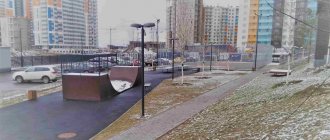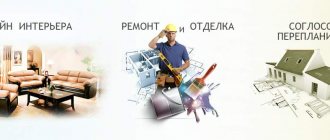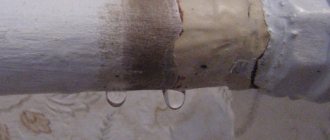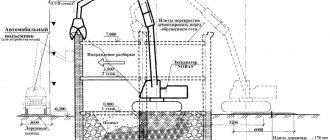Comprehensive Agreement (CSR). We service ALL engineering systems
When concluding a comprehensive contract for the maintenance of a country house, we take responsibility for the uninterrupted operation of all engineering systems: heating, water supply, boiler equipment, sewerage, ventilation, air conditioning.
Rules for choosing a material to solve a problem
When the cause of the pipe damage has been established, it is necessary to look for acceptable repair methods. There are several of them. Only most are suitable for low water pressure in the water supply circuit or heating system.
If you don’t have such a device at hand, then any piece of rubber (for example, from a bicycle inner tube) and wire or something similar will do .
But other methods of eliminating leaks when it comes to heating or hot water supply systems are unlikely to work. Thus, often used cold welding and special sealants are not relevant for wet surfaces.
Other instantly hardening composites (epoxy resin, dichloroethane) are also excluded, since they can be used on dry and disconnected water supply routes.
A minor leak in the pipeline can be repaired on your own . But this will only be a temporary measure. At the end of the heating season, it is recommended to carry out major repairs so that the system no longer fails.
Maintenance of individual heating points
ITP maintenance: key features
What are individual heating points, and what organizations provide maintenance of ITP? This question may be of interest to both apartment owners and happy owners of private houses.
ITPs are individual heating points that provide a constant supply of hot water and heat to apartment buildings, shopping complexes, and public buildings. The equipment of such a point includes heat exchangers (heaters), booster pumping stations, instrumentation, heat energy metering units, automation and shut-off and control valves.
Maintenance of IHP, like any complex engineering system, requires a professional approach and includes equipment maintenance, monitoring of operating condition, preparatory work for the beginning and end of the heating season. If necessary, current or major repairs of the system must be performed.
acid pumps for flushing heat exchangers
ITP maintenance is included in the range of services provided by the management company. The amount of heat supplied to the building, and therefore the amount of heating costs, depends on how professionally this organization fulfills its duties. The quality of service affects the duration of service work at the heating station and the service life of the equipment. If all work is completed on time and in full, then the building heating utility service will always be provided at the optimal level.
heat exchangers for IHP
All measures for the prevention and repair of equipment at a heating point must be carried out by specialists with specialized education and extensive experience. Their responsibilities include the following:
setting up an automatic control system (pressure and temperature sensors, electronic controller, direct-acting regulator) and adjusting its operation; control of the operation of pumping and heating equipment, selection of the optimal heat supply mode, depending on the ambient temperature, reconstruction of heat supply systems; preparing equipment for the beginning of the heating season and presenting the ITP to the organization that supplies electricity to the property.
Timely maintenance of heating stations makes it possible to avoid emergency situations during their operation.
ITP control algorithm
1.1. Regulation of coolant temperature in systems.
Maintaining the set temperature in the heating system depending on the outside air temperature, in accordance with the temperature schedule, with correction for the temperature of the coolant in the return pipeline, is carried out using freely programmable controllers. Temperature regulation is carried out using four sensors: one sensor is installed on the north side outside the building, the second sensor is on the supply pipeline of the circulation circuit of the system, the third and fourth sensors are on the forward and return coolant pipelines. If the coolant temperature deviates from the set one, the controller sends a command to the actuator of the control valve installed on the supply pipeline of the heating network. The control valve moves in one direction or another, changing the amount of coolant entering the system until the set temperature value in the circulation circuit of the heating system is restored.
1.2. Control of heating, ventilation and domestic hot water pumps
In order to create conditions for uniform mechanical wear, according to a schedule, the “main” - “backup” pump modes are automatically switched. When the main pump fails, the backup pump is automatically switched on with an alarm signal to the dispatch computer. In the event of a short-term power failure, after it is restored, the pump that was in the “main” mode at the time of shutdown will automatically turn on. The simultaneous activation of two pumps is excluded both at the electrical blocking level and at the program level.
1.3. Automation tools
— Programmable controllers; — Electric drives for control valves; — Outside air temperature sensors; — Submersible water temperature sensors; — Fluid pressure sensors; — Differential pressure sensors and relays on pumps.
So, an individual heating point is designed to provide hot water, heat supply and/or ventilation to various types of industrial complexes, housing and communal services facilities and residential buildings.
How it works?
The coolant entering the IHP through the thermal input supply pipeline, using a special device - a heat exchanger - transfers its heat to the heating and hot water supply (DHW) systems, and also enters the ventilation system, after which it is returned to the thermal input pipeline and sent back through the main networks to the city's heat generating enterprise for reuse. Some of the coolant may be consumed by the consumer.
Tap water entering the ITP passes through cold water supply pumps (CWS), after which part of the cold water is sent to consumers, and the other part is heated in the first stage hot water supply (DHW) heater and enters the circulation circuit of the DHW system. In the circulation circuit, water, with the help of hot water supply circulation pumps, moves in a circle from the ITP to consumers and back, and consumers take water from the circuit as needed. As it circulates through the circuit, the water gradually releases its heat and in order to maintain the water temperature at a given level, it is constantly heated in the second stage DHW heater.
The heat supply system is a closed loop through which the coolant moves with the help of heating circulation pumps from the IHP to the building heating system and back. During operation, coolant leaks may occur from the heating system circuit. To make up for losses, a heating point replenishment system is used, using the city’s primary heating networks as a source of coolant.
If you want August Housing and Communal Services to take care of the maintenance of your residential building, we ask you to call us at:
+7
Hot and cold H2O - is there a difference in the way the gap is sealed?
It's all about the difference in coolant temperature. It is this factor that is decisive when choosing a material.
With hot pressure, minor damage can heal without outside intervention . Larger gaps can be easily repaired with regular salt and a bandage.
But when the water cools, the flow will resume. It will not be possible to fix a leak in a cold water pipe with salt and a bandage. It is easier to repair a failed hot water pipe in the summer when it is turned off. Then you don’t have to control the temperature in the room while fixing the leak.
According to Appendix 4 of VSN 58-88:
APPENDIX 4
Recommended
List of basic maintenance works for buildings and facilities
Work performed during inspections of individual elements and premises
- Elimination of minor malfunctions in water supply and sewerage systems (changing gaskets in water taps, sealing drains, removing blockages, adjusting flush tanks, fastening sanitary fixtures, cleaning siphons, grinding in plug valves in mixers, stuffing seals, changing the ball float, replacing rubber gaskets at the bell and ball valve, installing limiters - throttle washers, cleaning the tank from lime deposits, etc.), strengthening loose devices at the points of their connection to the pipeline, strengthening pipelines.
- Elimination of minor malfunctions in central heating and hot water supply systems (adjustment of three-way valves, stuffing of seals, minor repairs of thermal insulation, etc.; replacement of steel radiators in case of leaks, disassembly, inspection and cleaning of air collectors, plungers, compensators of control valves, valves, gate valves; cleaning from scale of shut-off valves, etc.; strengthening of loose devices at the points of their connection to the pipeline, strengthening of pipelines).
- Elimination of minor malfunctions of electrical devices (wiping and changing burnt-out light bulbs in public areas, changing or repairing sockets and switches, minor electrical wiring repairs, etc.).
- Ventilation of wells.
- Checking the serviceability of sewer hoods.
- Checking the presence of draft in the smoke ventilation ducts.
- Checking the grounding of bathtubs.
- Minor repairs of stoves and hearths (strengthening doors, firebox sheets, etc.).
- Cleaning a sewer bed.
- Coating with red lead putty on fistulas, sections of steel roof ridges, etc.
- Checking the grounding of the electrical cable sheath, measuring the insulation resistance of the wires.
- Checking equipment grounding (pumps, panel fans).
- Cleaning and changing burnt-out light bulbs in stairwells, technical crawl spaces and attics.
- Elimination of minor electrical wiring faults.
- Replacement of sockets and switches.
Work performed to prepare buildings for operation in the spring and summer
- Strengthening drainpipes, elbows and funnels.
- Reactivation and repair of the irrigation system.
- Removing springs on entrance doors.
- Preservation of the central heating system.
- Repair of equipment for children's and sports grounds.
- Repair of sagging blind areas, sidewalks, pedestrian paths.
- Installation of an additional network of irrigation systems.
- Strengthening flag holders.
- Preservation of mobile public toilets (cleaning, disinfection, washing of equipment, touch-up painting, unloading springs, adjusting equipment).
- Work on opening vents in basements and ventilating attics. Inspection of façade roofs and basement floors.
Work performed to prepare buildings for operation in the autumn-winter period
- Insulation of window and balcony openings *.
- Replacement of broken glass windows, glass blocks and balcony doors *.
- Insulation of entrance doors to apartments *.
- Repair and insulation of attic floors.
- Repair and insulation of pipelines in attics and basements.
- Strengthening and repairing parapet fences.
- Glazing and closing of attic dormers.
- Manufacturing new or repairing existing walking boards and walkways in attics and basements.
- Repair, adjustment and testing of water supply and central heating systems.
- Repair of stoves and kitchen hearths.
- Repair and insulation of boilers.
- Repair, insulation and cleaning of smoke ventilation ducts.
- Replacement of broken glass blocks, glass windows, entrance doors and doors of auxiliary premises.
- Conservation of irrigation systems.
- Strengthening flag holders and license plates.
- Sealing vents in building basements.
- Repair and insulation of external water taps and standpipes.
- Repair and installation of springs on entrance doors.
Note: * Work in apartments is carried out by tenants.
- Repair and strengthening of entrance doors.
- Preservation of mobile public toilets (cleaning, disinfection, washing of equipment, touch-up painting, removal of devices and removal of water, drying, unloading of springs).
Other works
- Adjustment and adjustment of central heating systems during the testing period.
- Same ventilation.
- Flushing the central heating system.
- Cleaning and flushing water tanks.
- Adjustment and setup of automatic control systems for engineering equipment.
- Preparing buildings for the holidays.
- Well cleaning.
- Preparation of drainage systems for seasonal operation.
- Removing snow and ice from roofs.
- Cleaning the roof of debris, dirt, leaves.
List of works for current repairs of an apartment building
List of works for major repairs of an apartment building
How does the pipeline material affect the solution to the problem?
Metal pipes are distinguished by their enviable resistance and durability. Almost their only drawback is their susceptibility to corrosion. This is often what causes a leak in the circuit.
Less commonly, other pipelines also fail: plastic, polypropylene (mainly in places of threaded or fitting connections).
It is enough to compress the plastic pipe in the problem area, and all manipulations can be carried out under water pressure. The main thing is not to overdo it with the screed, otherwise the plastic will crack, and then you will have to replace the entire pipe.
A polypropylene pipeline can be easily repaired by soldering a separate fragment; a metal-plastic pipeline requires inserts . In the latter case, if the damage is not extensive, wrapping with electrical tape or treating with an adhesive (polyurethane, epoxy) will be sufficient.
How to solve a problem?
When water circulates under pressure in the pipes, most major repairs cannot be done. Therefore, you have to act in other available ways in order to at least temporarily stop the leak and wait for emergency services.
Using a self-tapping screw
This option is applicable only for minor holes with a diameter of no more than 3-4 mm .
To plug the hole, you need a galvanized self-tapping screw, which is additionally equipped with a press washer.
It is simply screwed into the hole and secured . As a result, the water is blocked. After such repairs, the pipe can last up to 3 years, but it is better to replace the burst fragment as soon as possible. In addition, a self-tapping screw inside the pipeline leads to clogging of the system.
Cementing
Cast iron or steel pipes can be easily patched using cementation.
The sequence of actions is as follows:
- Using a special hard metal brush, carefully remove the layer of rust in the area of the fistula. The metal that is being painted is also removed, even if this leads to an enlargement of the hole.
- Cut the bandage to a certain length and dip it in the cement solution.
- They wrap it around the crack in several passes to form a kind of cocoon.
- The top is coated with cement to secure the result.
Clamp
A clamp is a fairly simple design consisting of a metal ring, a rubber gasket and a tightening bolt.
This device is sold in stores, but in emergency situations you can quickly make it yourself. You will need a piece of plastic rubber, scissors and a metal clamp corresponding to the diameter of the pipe.
Further actions:
- clean the damaged area from rust;
- put on a clamp, and slip a rubber gasket under it;
- The coupling is pressed tightly.
If the pipe is very rusty, a clamp will be almost the only way to disguise the leak. This is because welding cannot be used here.
Bandage and table salt
Salt is ideal for sealing leaks in hot water pipes under pressure. Step-by-step instruction:
- Distribute digestive salt over the bandage in as large a layer as possible.
- Wrap it around the hole, preferably more tightly.
Sealant
Using sealant (also called “cold welding”) to eliminate leaks in existing pipelines is not productive, since there is no guarantee that the problem will be solved 100%.
This is due to the fact that such compositions are designed to work with dry surfaces , and condensate is present on pressure pipes.
But if there is a small crack, you can try to seal it with a heat-resistant sealant. Outwardly, it is similar to plasticine.
Break off a small piece, carefully crumple it with your fingers and insert it into the hole, followed by smearing it to the sides . Large holes cannot be masked this way; first you will need to insert a wooden chip.
Here you will need fiberglass fabric and BF-2 glue.
Step by step steps:
- the problem area is thoroughly cleaned of rusty particles and degreased with aviation gasoline (acetone is an alternative);
- wait 15 minutes until the surface dries;
- cut a tape from the fiberglass of such a width that it completely covers the area of the leak;
- an adhesive composition is applied along the edges, and epoxy resin is applied to the center;
- apply to the crack, press with your hand and wrap;
- fixed with copper wire.
Wire or harness
A method somewhat reminiscent of the one with a clamp . Only instead of it they take a medical tourniquet and any metal wire. Rubber is tightly wrapped around the damaged pipe fragment and tightened with wire.
Wooden chop
It is necessary to quickly plan a wedge-shaped peg of a suitable diameter from any piece of wood. Then they hammer it into the hole with a hammer.
How to stop a leak in a hidden pipe?
You won’t be particularly happy when a pipe hidden under a building structure starts leaking. Especially if the renovation has only recently been done. Since it is not always possible to quickly reach the source, you need to know how to temporarily stop the flow.
Here are a few techniques that are suitable for a water supply system in a private home:
In just a couple of hours, mustard will seal microcracks from inside the pipeline. When the leak is fixed, the circuit should be flushed.
- The heating system is temporarily filled with industrial sealant. It will settle on the internal surfaces of the pipeline and thereby stop water from seeping through microscopic gaps. After a major overhaul, the coolant is replaced with a new one.
Large holes cannot be sealed this way. Then they turn off the system, drain the water from the riser and begin straightening. Namely, it will be necessary to dismantle the structure and replace problematic spans. If you live in an apartment building, neighbors are warned about the upcoming event.
Advantages of service under the concluded Agreement
- regular maintenance of engineering systems;
- 24-hour service of an adjuster;
- priority service;
- 24/7 technical support;
- preferential tariff for scheduled and emergency repairs;
- engineer's recommendations on timely implementation of scheduled repairs.
Annual maintenance cost
The cost of maintenance does not depend on the size of the house. It is determined by the number and parameters of the systems being serviced and the number of required routine visits. You can find an example of calculating the cost of home maintenance in the appendix.
Procedure for concluding a maintenance contract
The conclusion of a contract for the maintenance of a country house occurs in 2 stages.
Stage 1: Inspection of the house by an engineer
A qualified engineer inspects your home, identifies existing weaknesses, draws up a passport of the home’s engineering systems and prepares a list of recommendations for bringing the engineering systems to 100% operational condition.
The house passport indicates:
- brands and models of equipment used;
- a list of necessary regulatory measures to ensure uninterrupted operation of the equipment;
- a list of one-time works necessary to ensure uninterrupted operation.
The house passport becomes an annex to the cottage maintenance contract. The list of routine maintenance must be agreed upon with you.
Our specialists also draw up and provide you with a schedule of preventative maintenance.
We also recommend that you install a GSM system for monitoring the status of ADL-GPRS engineering systems, which promptly notifies you of any breakdowns or malfunctions. Installation of the system is a recommended, but not mandatory condition for concluding an agreement for comprehensive maintenance of a country house.
Stage 2: Installer visit
After approval of the passport, service technicians come to you to carry out the first service.
The adjusters bring you your copy of the house passport and copies of the cottage maintenance agreement for signing.
Preventing the problem from recurring
It is easier to prevent problems in the heating circuit than to suddenly look for ways to eliminate them. So before the start of the heating season, communications are checked by testing, especially focusing on dangerous areas.
These include:
- level spans;
- threaded connections and welds;
- zone of joining sections at radiators;
- places of implantation of heating equipment;
- near fittings;
- hard-to-reach areas.
First, everything is checked by eye, then with the circuit running.









